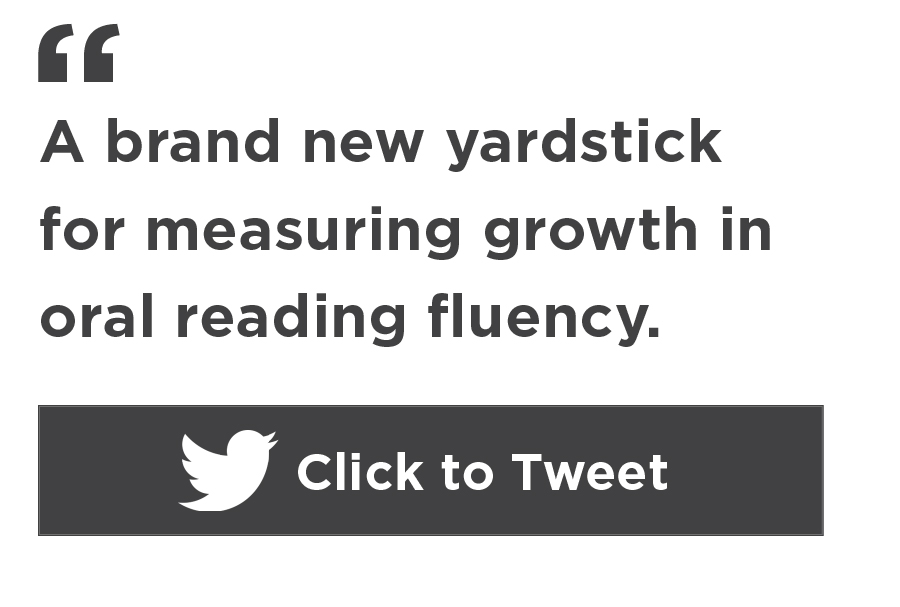When you’re a little obsessed with good measurement, you might find yourself a bit excited when someone gives you a brand-new measurement tool. It might even make you whistle the happy birthday song a little.
Because of our partnership with MetaMetrics®, MAP® Reading Fluency™ just got a shiny new yardstick: the Lexile® Framework for Oral Reading. It gives us an exciting and overdue new metric for gauging growth in oral reading fluency. The test itself is unchanged: reporting still includes key data showing how kids are doing with rate, accuracy, and literal comprehension. But the addition of the Lexile oral reading measure in reporting is a major step forward for framing overall growth in fluency. The new measurement places three components of oral reading onto a unified scale, which lets us see growth regardless of the specifics of how a student is improving their oral reading.
Let’s unpack that a little. Have you ever noticed that I like to talk about cars or speed when I’m really talking about reading fluency? I’m about to do that again to explain this new metric, so buckle up.
What makes a good driver?
My son has just mutated into the scariest kind of offspring anyone could possibly parent: the new driver. I’ve taken him out to practice just a few times. He sticks to parking lots and wide, deserted roads, and he keeps the speedometer hovering around 12 or 13 mph. When it’s time to drive home, I take over.
“Do you think Grant drove this road on the way to our house?” he recently asked while I drove. It’s a 45-mph stretch, and I could see that he admires his just-older cousin for being able to handle such a thing. Being able to go fast is clearly my son’s current metric for spotting better driving. And I’m with him, to some extent. I don’t want to be the mom responsible for that annoying slow car on the two-lane highway with no passing, the car that makes your road trip about 30% more road than trip.
But what do I really want to see? Precision, control, adaptability. Knowledge of how to handle sudden lightning + hail + high-speed winds during our Minnesota summers. Skill at driving through blowing snow and on roads coated with ice in the winter.
When we think about how to measure improvement at driving, the ability to go fast is not really all there is that matters. The same is true of reading.
What makes a fluent reader on the Lexile oral reading measure?
So how does this relate to the new Lexile Oral Reading framework? When we measure a student’s oral reading with this new yardstick, their Lexile oral reading measure will place their performance on a scale, based on these three things:
- Rate: How many words were read correctly per minute? We know rate matters because it gives us a great view into increasing automaticity, that ability to immediately know a word instead of having to sound it out. That’s why MAP Reading Fluency has always provided data on rate. Let’s imagine two students, Shoua and Ahmed, who both show scores of 80 words correct per minute (WCPM).
- Accuracy: What percentage of words were read correctly? Let’s imagine Shoua got 80 out of 120 words right as she read, while Ahmed got 80 out of 83. They show scores of 66% and 96% accuracy, respectively. While they share a WCPM score, they are two very different readers in terms of accuracy.
- Text difficulty: What is the oral readability of the text itself? If a student can read a college-level text at 80 WCPM with good accuracy, that’s quite a bit different from reading a second-grade text at 80 WCPM with good accuracy. Text difficulty matters, just as more difficult driving conditions matter when I gauge whether my son is becoming a good driver.
How will different kinds of growth be captured by this new scale?
This new three-factor yardstick is a gift because it lets us see and report growth for all the students we are helping, regardless of whether they are increasing their rate, their accuracy, or the text complexity they can handle.
Imagine that highly inaccurate Shoua has a Lexile oral reading measure of 130L. We want her to get better, and as we work with her we see that accuracy is where to focus. With the right instruction, soon she’ll be able to read at that same rate—80 WCPM—but with as much accuracy as Ahmed. Even though her WCPM doesn’t show growth, her Lexile oral reading measure will. It will go up significantly because she is becoming significantly better at oral reading.
Now imagine Ahmed again. We want him to get better, too. His Lexile oral reading measure can go up if he gets faster, but it can also go up if he starts to be able to read harder text at that same 80 WCPM with that same good accuracy.
Growth is more than just speed
A higher WCPM isn’t always the right focus as we think about improving a particular student’s fluency. But meaningful growth is always what we want. This new yardstick measures a more multi-factor kind of growth so we can better capture whether kids are growing in ways that add up to becoming fluent readers: automatic, accurate, and able to handle difficult terrain. Thank you, MetaMetrics!
And now, just a thought for you: any chance you could design a multi-factor yardstick for new drivers?








